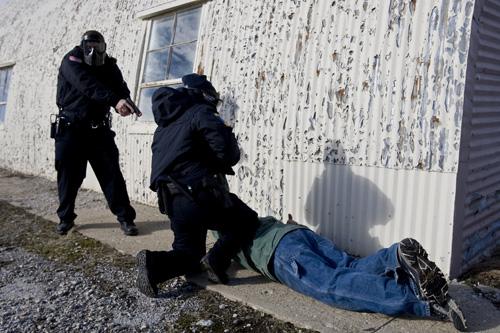Practice makes perfect for trainees in Police Training Institute

Erica Magda
December 4, 2007
Editor’s note: This is the first in a three-part series of articles profiling the University of Illinois Police Training Institute, which trains recruits from departments across the state through classroom instruction and created simulations.
Newly hired officers from counties around the state of Illinois arrived in full uniform at the University Police Training Institute’s training base at Willard Airport for patrol operations training Nov. 27.
By retrofitting the old airport hangar machine shops, the institute has created its own apartment complex to train recruits to analyze scenarios and take in debriefings. On this particularly brisk day of class, a group of rookie officers was tested in situations involving high-risk arrests, domestic disturbances – ranging from suicidal persons, a murder-suicide and a verbal domestic disturbance – and a building search.
“Our training is as close as we can replicate to real situations,” said W. Michael Miller, associate director of the institute. “We don’t have unwinnable scenarios, as long as proper tactics and strategies are used in each one.”
Get The Daily Illini in your inbox!
Founded in 1956 by a state statute, the institute strives to give recruits the best possible basic training in a rapid 12-week, 480-hour course.
During these scenario-based classes, role players are armed with paintball guns to give recruits, suited in Kevlar jackets, an idea of the realistic impact being shot causes. Recruits are armed with radios and airsoft guns, which fire and react as the real weapons would.
“We have volunteer role players and we instruct them to do very specific things,” said Ken Zimny, associate police training specialist. “We never control the officers and their responses, but we do control the role players.”
Zimny spent the session observing how recruits dealt with domestic disturbances. By controlling the role players’ actions, he and other instructors can put recruits in specific situations while realistically reconstructing conflicts often seen by professional officers, he said.
A debriefing session followed recruits’ completion of each scenario. The students discuss what happened during the practice and what they can improve upon with their instructor and each other.
“They discuss what they saw from different perspectives,” Miller said. “They are split into three groups, two of which will be observing from adjoining rooms (of the mock apartment complex) and one will be outside trying to diffuse the situation.”
Recruits receive basic tactical training by participating in these scenarios, but they are also taught cues to interpret peoples’ body language during domestic calls.
“Emotions are high,” Zimny said to his group of recruits during a debriefing session. “It gets very personal and you never know what you’re going into with domestic calls.”
By careful instruction of the role players and asking pointed questions of the recruits – such as “Did you ask (the victim) if (the offender) was on medication? Who was he threatening? Did he have any past history of violence?” – Zimny forces his recruits to think about all the possible issues and ideas when a situation presents itself.
“You need to think about all parts of the scenario and what can be utilized to help you,” Zimny said to his students.
Across town in the institute’s on-campus training facility, located at the intersection of Fourth and Chalmers streets, recruits are also trained in the classroom.
“All of the instructors are generalists with specialties,” said Doug Needham, police training specialist. “I spent most of my career enforcing drug laws and I enjoy teaching on family violence. I like anything that involves investigations.”
On Wednesday, Needham and Champaign Police Department Lt. Brad Yohnka instructed the class of recruits on how to successfully and diligently investigate a crime scene. Needham directed the students in sketching the crime scene and Yohnka focused on the collection and packaging of evidence.
“They have to think in terms of objectives,” Yohnka said. In the institute’s basement, six rooms had been set up for his class to investigate crime scenes, complete with weapons, blood and hidden evidence. Students were tested in the packaging of the evidence and how well they executed their investigation.
“They will come in and get briefed about what happened in the different crime scene areas and process their next action based off of what the first-responder said,” Yohnka said.
Recruits took photos, sketched the scene and collected evidence in addition to communicating with detectives as to where specific events occurred.
“The trainers here are some of the best with whom I’ve worked,” Needham said. “They impart knowledge to the students. We don’t make (the students) experts, but we familiarize them with the skills. Their agencies will develop these skills more, but we give them a foot in the door.”






